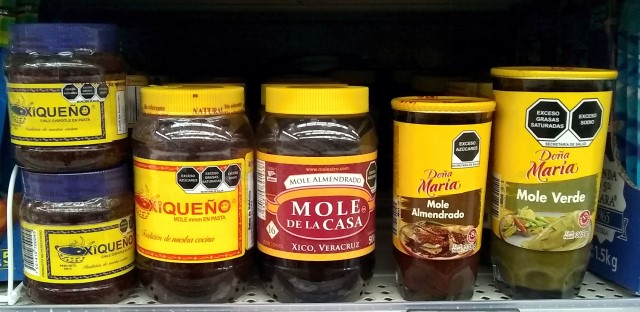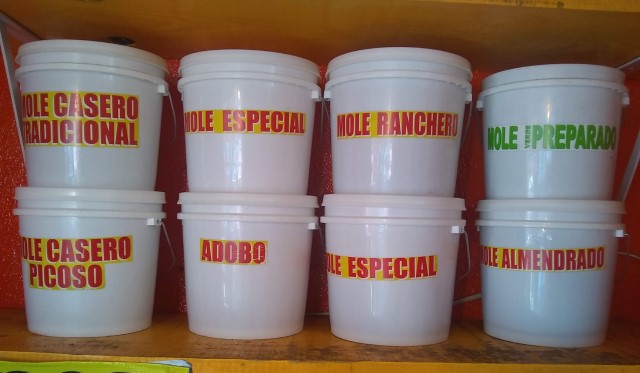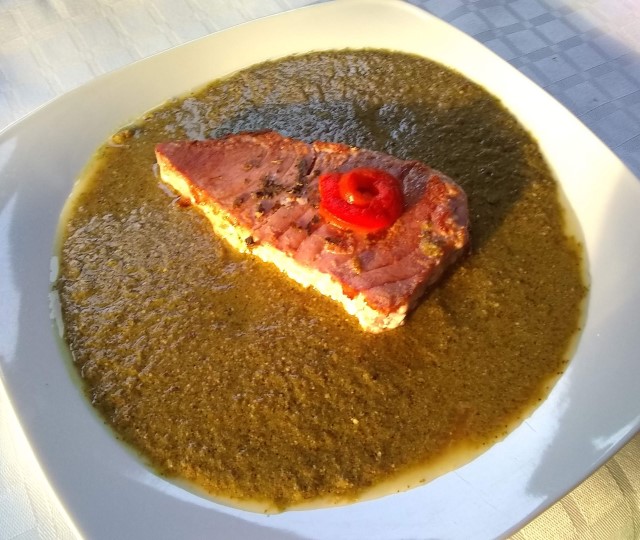
We all have had extraordinary experiences in nature or with music or with food, but when we try to reproduce them, sadly, it’s just not possible. Seems like that magic moment simply cannot exist twice. Savoring mole can be an experience of that sort.
Someone once said, “There are as many recipes for salsas as households in Mexico.” I submit the same goes for moles. While in the USA standardization may be the goal, in Mexico, flavor uniqueness, personality or “household signature flavor” is the norm. Nevertheless, somehow we are permanently looking for that fabulous original, authentic, pure, one in a million recipe that is going to transport us to heaven more than once. We can make the search our lifetime purpose but when we find it is almost impossible to keep it. The experience as a rule—with its due exemptions—can never be repeated.
Moles Adventures
I once found a mole verde in a fonda* in the market of Valle de Bravo—a beautiful town about 80 miles west of Mexico City—that I enjoyed immensely. One day driving from Zitácuaro, Michoacán to Mexico City with Diana Kennedy, we took a detour to see my weekend property which we used for about 20 years for ecological education purposes and Diana, an eco passionate, was curious to see. While in Valle de Bravo, I suggested that we go for lunch to try that mole verde. The place was named “La Fonda de Toño”, but guess what? That day, the mole was not perfect and Diana, as usual, did not hesitate to fully express it. She found however—and commended it—the cleanliness and beauty of the place extraordinary. She loved to see all the pots and pans hanging, perfectly arranged, spotless, inside the little establishment´s open kitchen. She told me that someone who takes pride in displaying his cooking tools must be a good cook, but the magic on the mole verde that we were after, just wasn’t there that day. Sometime later, I went back again by myself, looking for that memorable mole verde, and Toño, the cook and owner of the little establishment, had passed away…

In my perspective, mole is a sauce that usually has the following groups of ingredients: chiles, fruits (fresh and/or dried), seeds, herbs and spices plus sugar and salt. Any mole thus can have easily a dozen or dozens of ingredients! Having said that, you can now imagine the infinite combinations of a choice of those ingredients, and you can begin to see the magnitude of the universe of the different moles that are possible and that do exist! To further complicate the mole equation, add the flavors of—take your pick— turkey, pork, goat, chicken, insects, worms, seafood, and the result is nothing short of mind boggling. And we must not forget that the stock we use has also an important saying in the final flavor of the product. As you can see “the chocolate sauce”—as I often hear it referred to in the US—is a very limited concept, since chocolate can be only one of multiple ingredients a mole can have—if present, since it is not always the case…
Moles Sweet, Moles Spicy (and More)
Moles can be sweet, fruity, spicy, salty, fiery, and much more depending on the accent a specific ingredient can impart. This is decided by the mind and the hands of the cook, and his or her mood that day. The combination of chiles, herbs, spices, nuts, and chocolate, can produce unimaginable flavors! Here resides the element of surprise. In addition, mole ingredients have an effect on the brain. So, it is not just the look, flavor, smell or texture that affects our senses and determines our experience, some substances on the mole ingredients go to our brain to release endorphins that make us feel very good, crave for more, and at times reach ecstacy! Just think how a mix of endorphins produced by chiles, chocolate, and sugar combined will make you feel!

Many of us have heard the legend of the Siete Moles de Oaxaca, belonging each to seven regions of that beautiful state. The legend is a strong symbol of a rich cultural heritage. Oaxaca is the state in Mexico with the highest percentage of its population speaking native languages. It is an expression of pride of seven regions that is reflected also in their attire, crafts, customs, festivals, food among other traits. Politically, the state of Oaxaca today is divided in eight regions: Cañada, Costa, Istmo, Mixteca, Papaloapan, Sierra Sur, Sierra Norte y Valles Centrales, where you can find 570 municipalities and more than 11,000 communities. Due to the diversity in topography, climate, and ecosystems, you could say that there are eight states and cultures within Oaxaca, as the culture of the mountains has nothing to do with the culture of the Valles Centrales or that of the Isthmus of Tehuantepec. Even though those siete moles have been adopted to represent a different regional culture, there are other less known moles that due to the isolation of small towns hidden in the mountains where access is limited, muchos moles still need to travel to the capital Oaxaca City to be widely known. There are claims that Oaxaca has around twenty different moles, in my view, it’s a world yet to be discovered…
The Making Of
But making mole is no rocket science today. It is sold already made as a mix in a paste or as in powder form. The mix is dissolved with animal or vegetable stock and the sauce is ready. You can then custom manipulate the concoction by adding one or more ingredients of your liking and give your preparation a distinct personality or your “household signature flavor.” In reality this is easy and fun. My advice is get some mole in a paste or powder form and taste it prepared according to its instructions. Then see if you like it and begin to add bit by bit maybe chipotles en adobo or ground chile de árbol to make it spicier, chile pasilla for sophistication, brown sugar to make it sweeter, herbs and spices to achieve a more complex flavor, nuts for a more refined taste, or chocolate to please easy palates. I just bought red mole powder in bulk at around $2.75 per lb. and I´m going to make some mole this weekend. I feel like trying prune flavor this time. I will then buy some prunes, grind them in a blender with some stock, and add little by little to my mole pot until I reach the flavor I’m looking for; easy, right?
If you travel to Mexico, try muchos moles—don´t hesitate to ask for tastings before ordering one—and when you find an outstanding creation, enjoy it as much as possible, ask for seconds, try to get the recipe, and keep in mind that most likely that experience may not be repeated. If this is the case, you just had a once in a lifetime experience… Buen provecho!
*Humble food and drink public establishment
Muchos Moles Recipes
Mole de Frutas Secas

This is one of my favorite moles and the easiest one to make. Pick a mole mix in the store that is on the sweet side, avoid “picoso” moles, and you are more than half way towards a great mole experience. Give the mole your personal touch with dried fruit like prunes, figs, peaches, berries and the like. I recommend no more than three different dried fruits.
Ingredients
- 1 12 Oz. jar of commercial mole paste
- 2 to 3 Oz. Dried fruit of your choice
- 2 Qt, Hot vegetable or chicken stock
- 2 Oz. Mexican chocolate, Ibarra brand has less sugar. Optional
- Ground cinnamon to taste
- Brown sugar to taste
- Salt to taste
Instructions
- Preferably the day before it is going to be served, dissolve the mole paste in a pot by adding little by little the hot stock until you obtain a thick sauce.
- Turn on the stove and simmer the mole for 5 minutes. Check for taste.
- In a blender, grind the fruit with stock to a thick sauce and begin to add it to the mole little by little while simmering. Check for flavor.
- If you decided to use chocolate, this is the time to add a small piece, wait for it to dissolve and taste. The mole will thicken with time as ingredients absorb the liquid, you will need to add more stock. Add the cinnamon, sugar or salt to your liking at this time.
- When you are satisfied with the flavor turn the heat off and let it sit to cool off for a few hours or overnight. Mole will need stock or water to be reheated and served. You will notice the effect on flavor of the cooling off and reheating. Serve over rice or chicken. Enjoy!
Yield: 4 portions
Heat scale: mild
Mole Verde

A versatile and nutritious mole that can be enjoyed with chicken, pork or fish. The preparation time is less than an hour.
Ingredients
- 3 to 5 Oz. Pumpkin seeds lightly toasted
- 3 to 5 Oz. Sesame seeds lightly toasted
- 1 Chile poblano roasted, stemmed, peeled, seeded and deveined
- 2 Chiles serranos fresh, stemmed, seeded and deveined
- 4 Tomatillos
- 6 Butter lettuce leaves
- 6 Spinach leaves
- 2 Hoja Santa leaves (no substitute)
- 1 Small bunch of cilantro
- 2 Garlic cloves
- 2 Cloves
- 2 Allspice
- 2 Peppercorns
- 1 Pinch of oregano
- 2 Qt, Vegetable or chicken stock
- Salt to taste
Instructions
- If you prefer the taste of pumpkin seeds over sesame seeds, use 4 to 5 ounces of them while using only 3 ounces of sesame seeds. If otherwise, do the opposite.
- Once you have all the ingredients prepped, use a blender to grind and mix everything with the stock to a thick sauce consistency.
- In a pot, bring the mole to a boil and simmer between 3 and 5 minutes. Check for taste and adjust.
- Let it cool off and as in other moles, the ingredients will absorb the liquid and you will need stock to reheat it and serve. It goes well with chicken, turkey and fish, as well as pasta and rice. Enjoy!
Yield: 4 portions
Heat scale: hot






